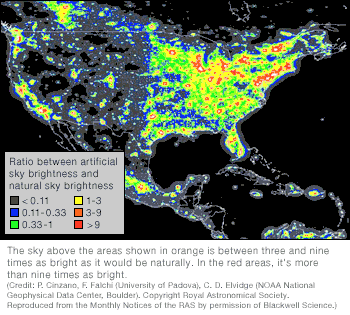The Threat of Light Pollution
About 99% of people in the USA and western Europe never see a truly dark starry sky from where they live. The cause? A relatively recent phenomenon known as "light pollution." It's difficult to see how light, a form of energy that we depend on, can act as a pollutant. But there is an excess of artificial light in the atmosphere around urban areas so much that it's blocking our view of the stars.

It's easy to understand how this is of concern to astronomers, both amateur and professional. Trying to see a fainter star from an urban area is like trying to spot a candle's light amidst a blaze of fireworks. The serious nature of light pollution has started some action:
International Dark-Sky Association is an organization created to preserve and protect the nighttime environment and our heritage of dark skies through quality outdoor lighting. Urbanization is a trend that will continue to grow, but even so, light pollution can be reduced. The greatest problem is that so much light is directed at the sky when there's actually no need for it. It's the ground, not the sky, that we need to illuminate. As light pollution activists see it, this is an easy problem to correct; all that's needed is better lighting design. Another benefit would be vast energy savings. In casting so much light to the sky, where it effectively goes unused, there is considerable waste of electrical energy. The International Dark Sky Association puts the cost to the United States at $1 billion per year.
Light Pollution Science and Technology Institute is an Italian institute which studies Light Pollution. They use a Satellite in the sky to monitor the sky brightness from artificial lights to study its affect on stellar visibility from the ground.